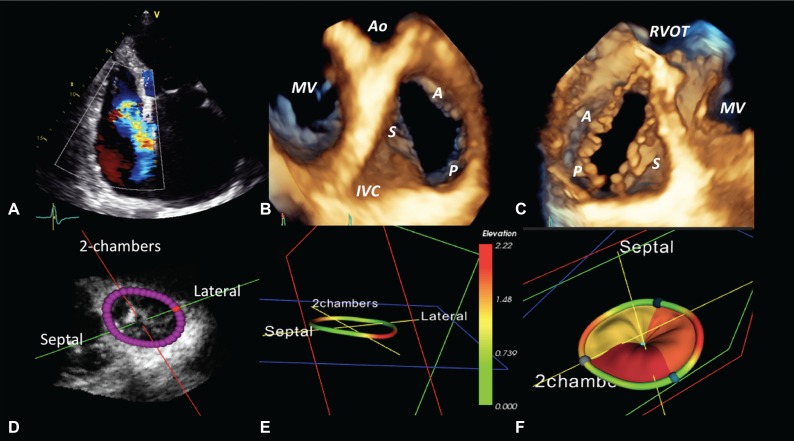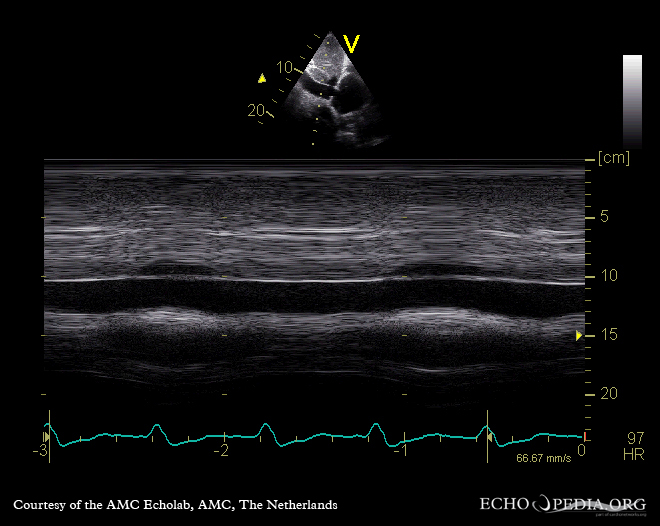Tricuspid regurgitation echocardiography
|
Tricuspid Regurgitation Microchapters |
|
Diagnosis |
|---|
|
Treatment |
|
Case Studies |
|
Tricuspid regurgitation echocardiography On the Web |
|
American Roentgen Ray Society Images of Tricuspid regurgitation echocardiography |
|
Risk calculators and risk factors for Tricuspid regurgitation echocardiography |
Editor-In-Chief: C. Michael Gibson, M.S., M.D. [1] ; Associate Editor(s)-in-Chief: Vamsikrishna Gunnam M.B.B.S [2] Rim Halaby, M.D. [3] Fatimo Biobaku M.B.B.S [4]
Overview
Transthoracic echocardiography (TTE) is usually adequate for the evaluation of tricuspid regurgitation; to confirm the diagnosis, determine the etiology, establish the baseline severity and for the assessment of the function of the right ventricle prior to surgery. In cases of non-diagnostic transthoracic studies, transesophageal echocardiography (TEE) improves the visualization of the valvular structure and delineates the mechanism and severity of regurgitation.
Echocardiography
Echocardiography with doppler is the method of choice for the non-invasive detection and evaluation of the severity and etiology of valvular regurgitation. [1][2]Echocardiography allows the evaluation of the following:[3][4][5][6][7][8]
- Right ventricle structure and function
- Right atrium structure and function
- Inferior vena cava
- The structure and function of the left chambers of the heart
- The structures of the tricuspid valve and the underlying etiology of mitral regurgitation
- Pulmonary artery pressure
- Pressures in the heart chambers
- The severity of the tricuspid regurgitation through the measurement of:
- The tricuspid annular diameter in the apical 4-chamber view
- Tricuspid valve leaflet tethering height
- Tricuspid valve leaflet tethering area
- Tricuspid regurgitation jet velocity signal
- Characteristic primary valvular abnormalities can be detected by tricuspid valve motion which includes the conditions like:[9][10]
- Ebstein's anomaly
- Carcinoid heart disease
- Rheumatic valve disease
- Tricuspid valve prolapse
- Flail leaflet
- Endocarditis
- By using the vena contracta method with colour doppler we can estimate the severity of the tricuspid regurgitation and that includes:
- The vena contracta width has to be more than 0.7 cm along with systolic flow reversal in the hepatic veins
- In the presence of atrial fibrillation, systolic flow reversal in the hepatic veins cannot be accurate
- By using the modified Bernoulli equation, we can estimate pulmonary hypertension on echocardiography by measuring the right ventricle to right atrial systolic gradient from the velocity of the tricuspid regurgitation jet


Video demonstrating Tricuspid regurgitation on an echocardiogram
{{#ev:youtube|UHNKYKyorJo}}
2020 ACC/AHA Guideline for the Management of Patients With Valvular Heart Disease A Report of the American College of Cardiology/American Heart Association Joint Committee on Clinical Practice Guidelines[12]
Recommendations for Diagnosis of TR
| Class I |
| 1. In patients with TR, TTE is indicated to evaluate the presence and severity of TR, determine the etiology, measure the sizes of the right-sided chambers and inferior vena cava, assess RV systolic function, estimate pulmonary artery systolic pressure, and characterize any associated left-sided heart disease. (Level of Evidence: C-LD)" |
2014 AHA/ACC Guideline for the Management of Patients With Valvular Heart Disease: Executive Summary[3]
| Class I |
| "1. TTE is indicated to evaluate severity of TR, determine etiology, measure sizes of right-sided chambers and inferior vena cava, assess RV systolic function, estimate pulmonary artery systolic pressure, and characterize any associated left-sided heart disease. (Level of Evidence: C)" |
| Class IIb |
| "1. CMR or real-time 3-dimensional echocardiography may be considered for assessment of RV systolic function and systolic and diastolic volumes in patients with severe TR (stages C and D) and suboptimal 2-dimensional echocardiograms. (Level of Evidence: C)" |
==2008 ACC/AHA Guidelines for the Management of Patients with Valvular Heart Disease - Evaluation of Tricuspid Valve Disease in Adolescents and Young Adults(DO NOT EDIT)[13]
| Class I |
| "1. Doppler echocardiography is indicated for the initial evaluation of adolescent and young adult patients with TR, and serially every 1 to 3 years, depending on severity. (Level C)" |
Sources
- 2008 ACC/AHA Guidelines incorporated into the 2006 guidelines for the management of patients with valvular heart disease [13]
References
- ↑ Tornos Mas P, Rodríguez-Palomares JF, Antunes MJ (2015). "Secondary tricuspid valve regurgitation: a forgotten entity". Heart. 101 (22): 1840–8. doi:10.1136/heartjnl-2014-307252. PMC 4680164. PMID 26503944.
- ↑ Zoghbi WA, Enriquez-Sarano M, Foster E, Grayburn PA, Kraft CD, Levine RA; et al. (2003). "Recommendations for evaluation of the severity of native valvular regurgitation with two-dimensional and Doppler echocardiography". J Am Soc Echocardiogr. 16 (7): 777–802. doi:10.1016/S0894-7317(03)00335-3. PMID 12835667 PMID: 12835667 Check
|pmid=value (help). - ↑ 3.0 3.1 Nishimura RA, Otto CM, Bonow RO, Carabello BA, Erwin JP, Guyton RA; et al. (2014). "2014 AHA/ACC Guideline for the Management of Patients With Valvular Heart Disease: executive summary: a report of the American College of Cardiology/American Heart Association Task Force on Practice Guidelines". Circulation. 129 (23): 2440–92. doi:10.1161/CIR.0000000000000029. PMID 24589852.
- ↑ Chen TE, Kwon SH, Enriquez-Sarano M, Wong BF, Mankad SV (2013). "Three-dimensional color Doppler echocardiographic quantification of tricuspid regurgitation orifice area: comparison with conventional two-dimensional measures". J Am Soc Echocardiogr. 26 (10): 1143–1152. doi:10.1016/j.echo.2013.07.020. PMID 23993694.
- ↑ de Agustin JA, Viliani D, Vieira C, Islas F, Marcos-Alberca P, Gomez de Diego JJ; et al. (2013). "Proximal isovelocity surface area by single-beat three-dimensional color Doppler echocardiography applied for tricuspid regurgitation quantification". J Am Soc Echocardiogr. 26 (9): 1063–72. doi:10.1016/j.echo.2013.06.006. PMID 23860094.
- ↑ Zoghbi, William A.; Adams, David; Bonow, Robert O.; Enriquez-Sarano, Maurice; Foster, Elyse; Grayburn, Paul A.; Hahn, Rebecca T.; Han, Yuchi; Hung, Judy; Lang, Roberto M.; Little, Stephen H.; Shah, Dipan J.; Shernan, Stanton; Thavendiranathan, Paaladinesh; Thomas, James D.; Weissman, Neil J. (2017). "Recommendations for Noninvasive Evaluation of Native Valvular Regurgitation". Journal of the American Society of Echocardiography. 30 (4): 303–371. doi:10.1016/j.echo.2017.01.007. ISSN 0894-7317.
- ↑ Hahn, Rebecca T.; Thomas, James D.; Khalique, Omar K.; Cavalcante, João L.; Praz, Fabien; Zoghbi, William A. (2019). "Imaging Assessment of Tricuspid Regurgitation Severity". JACC: Cardiovascular Imaging. 12 (3): 469–490. doi:10.1016/j.jcmg.2018.07.033. ISSN 1936-878X.
- ↑ Hudzik B, Poloński L, Gąsior M (2016). "Lancisi sign: giant C-V waves of tricuspid regurgitation". Intern Emerg Med. 11 (8): 1139–1140. doi:10.1007/s11739-015-1384-4. PMC 5114320. PMID 26758273.
- ↑ Adler, Dale S. (2017). "Non-functional tricuspid valve disease". Annals of Cardiothoracic Surgery. 6 (3): 204–213. doi:10.21037/acs.2017.04.04. ISSN 2225-319X.
- ↑ Paranon, S.; Acar, P. (2008). "Ebstein's anomaly of the tricuspid valve: from fetus to adult". Heart. 94 (2): 237–243. doi:10.1136/hrt.2006.105262. ISSN 1355-6037.
- ↑ "Revisit of Functional Tricuspid Regurgitation; Current Trends in the Diagnosis and Management".
- ↑ Otto CM, Nishimura RA, Bonow RO, Carabello BA, Erwin JP, Gentile F; et al. (2021). "2020 ACC/AHA Guideline for the Management of Patients With Valvular Heart Disease: A Report of the American College of Cardiology/American Heart Association Joint Committee on Clinical Practice Guidelines". Circulation. 143 (5): e72–e227. doi:10.1161/CIR.0000000000000923. PMID 33332150 Check
|pmid=value (help). - ↑ 13.0 13.1 Bonow RO, Carabello BA, Chatterjee K; et al. (2008). "2008 Focused update incorporated into the ACC/AHA 2006 guidelines for the management of patients with valvular heart disease: a report of the American College of Cardiology/American Heart Association Task Force on Practice Guidelines (Writing Committee to Revise the 1998 Guidelines for the Management of Patients With Valvular Heart Disease): endorsed by the Society of Cardiovascular Anesthesiologists, Society for Cardiovascular Angiography and Interventions, and Society of Thoracic Surgeons". Circulation. 118 (15): e523–661. doi:10.1161/CIRCULATIONAHA.108.190748. PMID 18820172. Unknown parameter
|month=ignored (help)